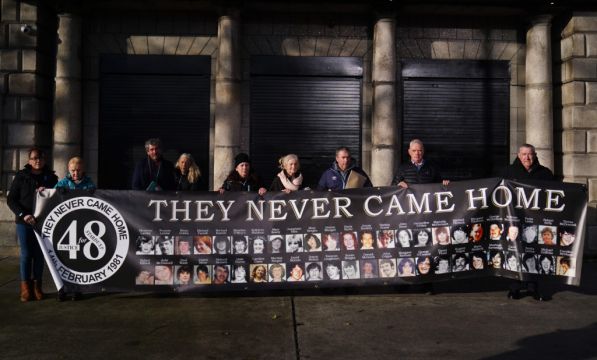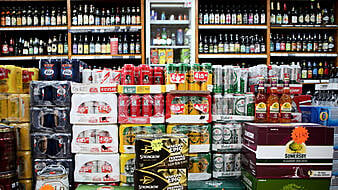The Stardust nightclub fire would have been less likely to spread without the presence of carpet tiles on the walls, an expert witness has told an inquest jury.
Dr Will Hutchinson also told the Dublin District Coroner’s Court a low ceiling that intensified the heat, the foam on the seats and burning droplets that started other small fires all contributed to the spread of the blaze that killed 48 people when it swept through the nightclub in Artane in the early hours of Valentine’s Day, 1981.
The fire investigator on Wednesday told Mark Tottenham BL, a member of the coroner's legal team, that, as the fire was first seen in the nightclub’s west alcove, it either started there or spread there without anyone else first seeing it.
Dr Hutchinson referred to photographs showing the aftermath of the fire and said the photos showed that there was significantly less heat inside the main bar, with certain areas relatively undamaged.
Coroner Dr Myra Cullinane asked him if there was disproportionate damage near the hot press, to which Dr Hutchinson replied that the section behind the hot press was severely fire-damaged compared to the rest of the bar.
Mr Tottenham asked him how the hot press burned when nothing around it had burned, to which Dr Hutchinson said that either the fire originated inside the cabinet and broke through a gap in the ceiling, or the fire started somewhere else, got into the ceiling void, and then dropped back down into the hot press.
He confirmed that the fire could have gone either way; it could have started in the hot press and gone out or the fire could have gone into the hot press from another origin.
He said that fires in hot presses are reasonably common due to faults in the immersion heater.
Mr Tottenham said that if the fire started there, it clearly needed to spread to the west alcove, although he acknowledged that there was an element of speculation about this.
He referred to the evidence of a barman, who had told the inquest that after a concert, roof tiles were damaged and temporarily fixed-up with black plastic bags. Mr Tottenham proposed a hypothesis that if a black plastic bag had been left in that ceiling space, it might have led the fire to travel across.
“The flames develop and, almost like a chimney, want to go upwards towards where there’s oxygen. They would keep going directly upwards, but directly above that is a cold-water tank which would deflect this flame,” Dr Hutchinson said, adding that there was a possibility that the flames rolled over and ignited any combustible material there.
“We are speculating,” he said.
Source
Dr Hutchinson said it was noted that there was corrosion around the connection to the immersion heater in the hot press.
He said that this can build up resistance for a current to pass through, making that area hotter which could lead to an incendive electrical fault.
Dr Hutchinson confirmed to Mr Tottenham that due to the pattern of damage to the hot press and its proximity to the west alcove, this was a possible source of the fire.
He confirmed that the fire was unlikely to have started in the roof space, so it might have started in the hot press or started in the west alcove itself.
Mr Tottenham asked if it could have started under a seat in the alcove, to which Dr Hutchinson replied that this was possible, but you would need significant material to do that, such as a burning newspaper or jacket.
Dr Cullinane interjected to remind the jury that they have not heard any evidence of that, and this was just a hypothesis.
Dr Hutchinson said you would need an intermediate material that would sustain a fire long enough for it to burn through the PVC coating on the seats.
He said it was not possible to directly ignite a bench of seats by dropping a cigarette or match onto it, so either it was a damaged seat or there was an intermediate material.
He said there was no way of knowing if there was a damaged PVC covering, and there was no evidence of intermediate material found, but if the intermediary were a cigarette packet it would have been consumed by the fire.
He confirmed that it would be speculation to conclude if such an origin had been accidental or deliberate.
Mr Tottenham said gardaí had spoken to some 1,400 people and were unable to establish if anyone had started it, so it was an act of speculation to conclude the fire started there.
Dr Hutchinson confirmed that it was a reasonable possibility that the fire started on top of the immersion heater in the hot press, adding that it was unlikely that the fire started due to an electrical fault in the west alcove, on the basis that experts carried out an examination of sockets there and found no fault.
Spread
Mr Tottenham next asked the witness about the possibilities of how the fire spread.
Dr Hutchinson said that while there was polyurethane on the seats, which is a readily ignitable material, the fire will slowly develop across a unit of seats without spreading to others. He said what was needed was interaction with burning carpet tiles, which were made of polyester.
“Polyester is a plastic, so it will also burn readily once ignited and will melt and fall in burning droplets, producing large amounts of black smoke,” Dr Hutchinson said, confirming that had there been no carpet tiles, the fire would have been less likely to spread to other areas.
Concerning the height of the ceiling in the west alcove, which Mr Tottenham said was a little bit below the statutory height, Dr Hutchinson said that there would have been downward radiation.
He explained that hot gases rise upwards and are stopped by the suspended ceiling, which in this case was not that far above the seats that are on fire.
He said that the gas layer starts moving downwards and gets closer to flammable material, and it is then sufficient to ignite everything beneath it.
“If the fire started elsewhere, it is going to take much longer for that hot gas layer to become dangerous because it's much higher up. Because this fire started at the top of one of the alcoves closer to the ceiling, that means that this process is much faster,” he said.
Concerning the failure of the fire extinguishers used on the night to fight the fire, Dr Hutchinson said that polyurethane foam melts and pools, so by squirting water on it the fire is shifted across.
“They’re not making it necessarily worse, but they are moving it across to another area,” he said.
Concerning the evidence of several witnesses about burning droplets falling from the ceiling, Dr Hutchinson said that when a fire is growing, bits of burning material can be brought up through air currents and there can be debris brought up into the hot gas layer that then falls back out of the air.
He said it was most likely that the ceiling tiles would not burn, as they were designed not to burn, but they were not fully non-combustible and can add something to a fire.
The witness confirmed that there were a number of contributing factors to the spread of the fire, including the foam on the seats, the flammable gases, the carpet tiles on the walls, the low ceiling that intensifies the heat, and the burning droplets that started other small fires.
He also confirmed that he could not determine exactly where the origin of the fire was, but it was either the hot press, a fire above the west alcove, a seat in the west alcove, or underneath a seat in the west alcove.
The inquest continues on Thursday in the Pillar Room of the Rotunda Hospital.







